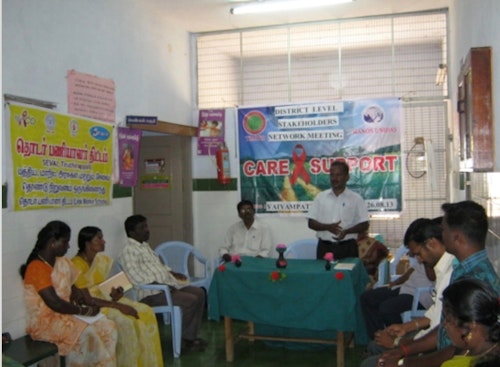HIV Project
SEVAI had been implementing HIV PROJECT in Tiruchirapalli District.
The main focus of this intervention is HIV prevention, care and support and treatment, and specifically to reach out to:
I.) HGRs-High Risk Groups
II.) VP-vulnerable men and women
III.) BP-Bridge Population such as truckers and their spouses and partners and
IV.) OVC- Other vulnerable children and
V.) PLHA People living with HIV/AIDS in rural areas with information, knowledge, skills on STI/HIV prevention and risk reduction.
The HIV project is useful to reach out to the rural population with the focus among the high risk population such as youth, women etc. The program will cover 100 most vulnerable villages through a mapping exercise. The high risk group identified through this Link Workers Scheme of SEVAI implementing Target Intervention in the Trichirappalli district for promoting behaviour change and linked with other services.
- High Risk Groups(HRGs): are Female Sex Workers(FSWs)
- Men having sex with Men(MSM)
- Bridge Population (BP): the Population consists of all migrants (male and female) and truckers.
- Vulnerable Population(VP); This group includes spouses and partners of MSMs,FSWs and spouses of migrants and truckers;out of school youth (male and female)and women in women headed households.
- OVC-Other vulnerable children.
- PLHA–Persons living with HIV/AIDS
WHY HIV PROJECT?
- Over the years virus has moved from the urban to rural areas
- From High risk to general population
- Disproportionately affecting women and the youth
- 38% of total infections are among women
- 37% of total infection are among young persons <29 years
- Over 57% of the infected live in rural areas
OBJECTIVES OF THE HIV PROJECT
HIV scheme will make an effort to build a community-centred model for rural areas. This will include an outreach strategy to address the HIV prevention, care and support and treatment requirements in Tiruchirapalli districts. The specific objective of the scheme includes: Reach out to HRGs and vulnerable men and women in rural areas with information, knowledge, skills on STI (Sexually transmitted Infection)/HIV prevention and risk reduction

This entails:
- Increasing the availability and use of condoms among HRGs and other vulnerable men and women.
- Establishing referral and follow-up linkages for various services including treatment for STIs, testing and treatment for TB(Tuberculosis), ICTC(integrated counseling and testing centre)/PPTCT Prevention of parent to child transmission services)services, HIV care and support services including ART(Anti Retroviral Therapy).
- Creating an enabling environment for PLHA and their families, reducing stigma and discrimination against them through interactions with existing community structures/groups, e.g. Village Health Committees (VHC), Self Help Groups (SHG) and Panchayati Raj Institutes (PRI).
- The population groups that are at-risk and vulnerable to HIV infection as well as persons living with HIV/AIDS include
EXPECTED OUTCOMES OF THE HIV PROJECT
- A cadre of trained local people- the Link Workers and Volunteers
- Increase in knowledge on HIV transmission, risk behaviours, HIV prevention and available health services among HRGs and vulnerable young people and women
- Increase in knowledge on HIV transmission, risk behaviours, HIV prevention and available health services among community members
- Increased use of condoms by HRGs, their partners and clients.
- Increased utilization of STI management , ICTC, PPTCT and ART services by HRGs, their partners and clients
RATIONALE FOR LINK WORKERS SCHEME IN TIRUCHIRAPALLI DISTRICT
- Large no of High risk groups in rural areas
- Village based vulnerable youth, men and women
- Large no of Bridge population (Migrants and truckers)
- Challenges in reaching prevention services in rural areas, Emphasize its more on local level (district to village coverage) and Convergence.
- Reduce stigma and discrimination against Persons Living with HIV/AIDS and their families.
AREAS OF CONVERGENCE
- Have coordination, regular meetings and experience sharing with programmes addressing HRIs and bridge populations in the Districts.
- Work with the communication campaigns and initiatives to address HIV/AIDS issues.
- Work with District-level departments.
- Manage the integration of services.
- Work with PRI institutions.
- Work with officers of RCH, TB, and NRHM (National Rural Health Mission).
- Facilitate and monitor integration of support and treatment.
- Promote synergy between HIV/AIDS initiatives.
- Facilitate social support to PLHAs and families.
